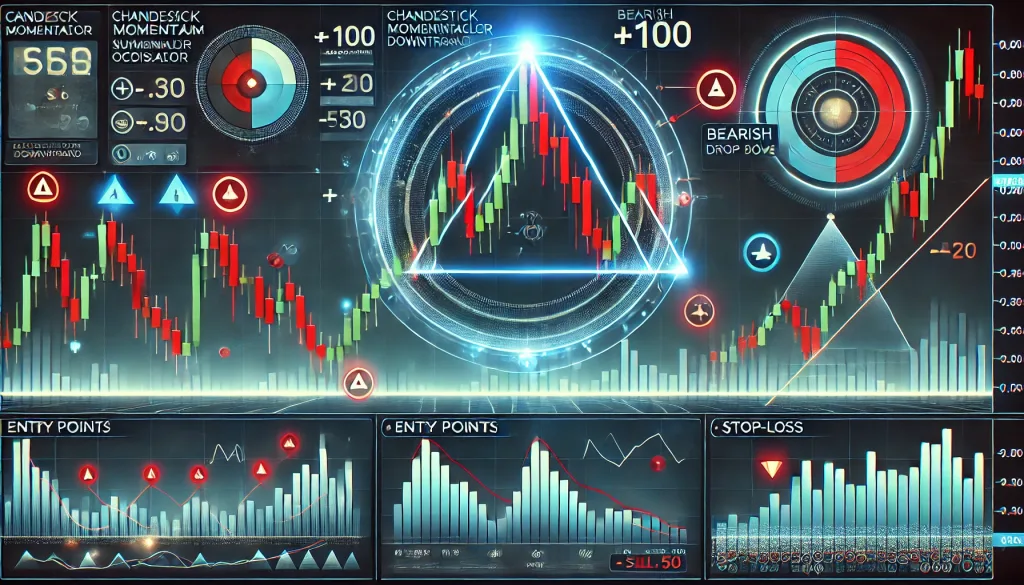The Secret Weapon of Smart Traders: Chande Momentum Oscillator Meets Bearish Pennant

The Indicator That Sees What You Don’t
Imagine if you had X-ray vision in trading. You could spot market momentum shifts before they happen, giving you an almost unfair advantage. Well, meet the Chande Momentum Oscillator (CMO)—an underrated momentum indicator that’s like the Swiss Army knife of technical analysis. Most traders ignore it, yet those who master it unlock next-level trading insights.
Now, let’s mix in a powerful pattern: the Bearish Pennant—a deceptive trap where retail traders go long while the pros get ready to short.
Put these two together, and you have a game-changing approach that could help you time your trades with sniper-like precision.
What is the Chande Momentum Oscillator (CMO)?
Unlike the RSI or MACD, which react after the market moves, the CMO identifies shifts in buying and selling pressure before they show up in price action.
Created by Tushar Chande, this oscillator moves between +100 and -100, measuring the difference between recent gains and losses. Unlike RSI, which normalizes data, CMO gives a raw look at price movement intensity.
Why It’s Different from RSI and MACD:
- Faster response to momentum shifts (great for short-term traders)
- Doesn’t smooth out data, meaning you get sharper signals
- Detects overbought and oversold conditions with greater precision
- Best used in combination with patterns like the Bearish Pennant
Bearish Pennant: The Retail Trader’s Nightmare
The Bearish Pennant is a continuation pattern that forms after a sharp downtrend, creating a small consolidation phase before breaking lower.
Why Do Most Traders Get It Wrong?
- They mistake the pennant for a reversal signal and go long.
- They enter too early, ignoring the critical breakdown level.
- They don’t combine it with a momentum indicator like the CMO for confirmation.
How to Trade the Bearish Pennant Using CMO
Here’s how to combine the CMO with a Bearish Pennant for high-probability trades:
- Identify a Strong Downtrend – Ensure the market has already experienced a significant drop before forming a pennant.
- Spot the Pennant Formation – Look for price consolidation that forms a symmetrical triangle or flag.
- Check the CMO Value – If CMO is still above -50, momentum hasn’t shifted enough yet. Wait for it to dip below -50 before considering an entry.
- Set Your Entry at the Breakout Level – Enter after price breaks below the pennant support.
- Place Stop-Loss Above the Pennant High – This protects you from false breakouts.
- Target the Next Support Level – Typically, the height of the previous downtrend leg is a good projection for your target.
Real-World Example: How Pros Trade This Setup
Case Study: EUR/USD Drops Like a Rock
In August 2023, EUR/USD formed a Bearish Pennant after a 200-pip downtrend. Many traders anticipated a reversal, but smart money used the CMO for confirmation. Here’s what happened:
- The pennant formed at 1.0950
- CMO dropped from -40 to -60, signaling increasing bearish momentum
- EUR/USD broke below 1.0900, triggering massive sell orders
- Price plummeted another 150 pips, following the pennant target
Common Mistakes and How to Avoid Them
❌ Ignoring the CMO’s Confirmation – Don’t short a Bearish Pennant unless the CMO confirms weakening momentum.
❌ Setting Stop-Losses Too Tight – Give the trade enough breathing room by placing stops above the pennant’s high.
❌ Chasing the Breakout – If you enter too late, you risk getting in after most of the move has already happened.
Final Thoughts: Why This Combo Works
The Chande Momentum Oscillator isn’t just another indicator—it’s an edge. When combined with the Bearish Pennant, it helps filter out false signals and boosts trade accuracy.
Don’t trade on guesswork. Use data, momentum confirmation, and smart setups to gain an advantage in the markets.
—————–
Image Credits: Cover image at the top is AI-generated
PLEASE NOTE: This is not trading advice. It is educational content. Markets are influenced by numerous factors, and their reactions can vary each time.

Anne Durrell & Mo
About the Author
Anne Durrell (aka Anne Abouzeid), a former teacher, has a unique talent for transforming complex Forex concepts into something easy, accessible, and even fun. With a blend of humor and in-depth market insight, Anne makes learning about Forex both enlightening and entertaining. She began her trading journey alongside her husband, Mohamed Abouzeid, and they have now been trading full-time for over 12 years.
Anne loves writing and sharing her expertise. For those new to trading, she provides a variety of free forex courses on StarseedFX. If you enjoy the content and want to support her work, consider joining The StarseedFX Community, where you will get daily market insights and trading alerts.
Share This Articles
Recent Articles
The GBP/NZD Magic Trick: How Genetic Algorithms Can Transform Your Forex Strategy
The British Pound-New Zealand Dollar: Genetic Algorithms and the Hidden Forces Shaping Currency Pairs
Chande Momentum Oscillator Hack for AUD/JPY
The Forgotten Momentum Trick That’s Quietly Dominating AUD/JPY Why Most Traders Miss the Signal
Bearish Market Hack HFT Firms Hope You’ll Never Learn
The One Bearish Market Hack High Frequency Traders Don't Want You to Know The

